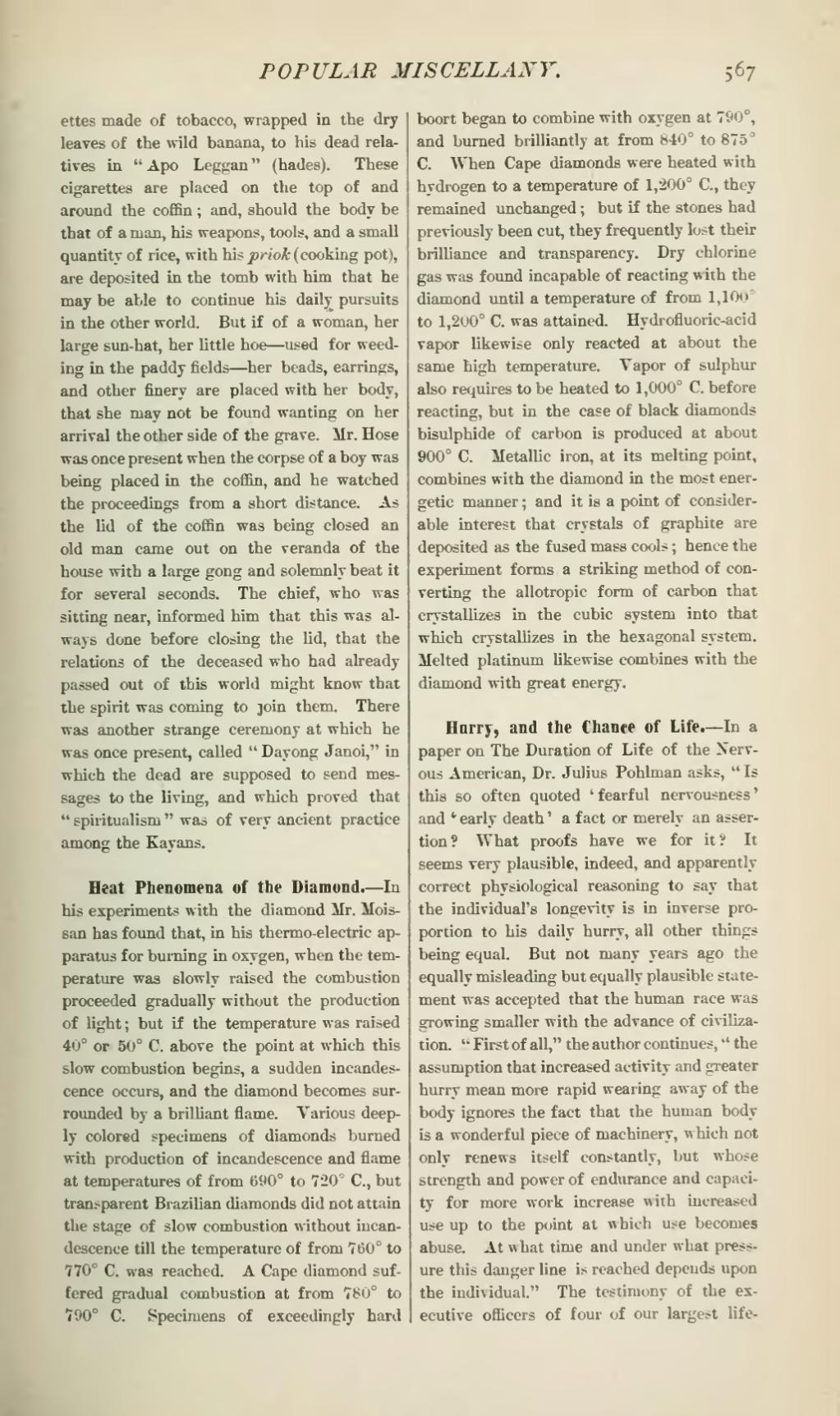ettes made of tobacco, wrapped in the dry leaves of the wild banana, to his dead relatives in "Apo Leggan" (hades). These cigarettes are placed on the top of and around the coffin; and, should the body be that of a man, his weapons, tools, and a small quantity of rice, with his priok (cooking pot), are deposited in the tomb with him that he may be able to continue his daily pursuits in the other world. But if of a woman, her large sun-hat, her little hoe—used for weeding in the paddy fields—her beads, earrings, and other finery are placed with her body, that she may not be found wanting on her arrival the other side of the grave. Mr. Hose was once present when the corpse of a boy was being placed in the coffin, and he watched the proceedings from a short distance. As the lid of the coffin was being closed an old man came out on the veranda of the house with a large gong and solemnly beat it for several seconds. The chief, who was sitting near, informed him that this was always done before closing the lid, that the relations of the deceased who had already passed out of this world might know that the spirit was coming to join them. There was another strange ceremony at which he was once present, called "Dayong Janoi," in which the dead are supposed to send messages to the living, and which proved that "spiritualism" was of very ancient practice among the Kayans.
Heat Phenomena of the Diamond.—In his experiments with the diamond Mr. Moissan has found that, in his thermo-electric apparatus for burning in oxygen, when the temperature was slowly raised the combustion proceeded gradually without the production of light; but if the temperature was raised 40° or 50° C. above the point at which this slow combustion begins, a sudden incandescence occurs, and the diamond becomes surrounded by a brilliant flame. Various deeply colored specimens of diamonds burned with production of incandescence and flame at temperatures of from 690° to 720º C, but transparent Brazilian diamonds did not attain the stage of slow combustion without incandescence till the temperature of from 760° to 770° C. was reached. A Cape diamond suffered gradual combustion at from 780° to 790° C. Specimens of exceedingly hard boort began to combine with oxygen at 790°, and burned brilliantly at from 840° to 875° C. When Cape diamonds were heated with hydrogen to a temperature of 1,200° C, they remained unchanged; but if the stones had previously been cut, they frequently lost their brilliance and transparency. Dry chlorine gas was found incapable of reacting with the diamond until a temperature of from 1,100º to 1,200º C. was attained. Hydrofluoric-acid vapor likewise only reacted at about the same high temperature. Vapor of sulphur also requires to be heated to 1,000° C. before reacting, but in the case of black diamonds bisulphide of carbon is produced at about 900º C. Metallic iron, at its melting point, combines with the diamond in the most energetic manner; and it is a point of considerable interest that crystals of graphite are deposited as the fused mass cools; hence the experiment forms a striking method of converting the allotropic form of carbon that crystallizes in the cubic system into that which crystallizes in the hexagonal system. Melted platinum likewise combines with the diamond with great energy.
Hurry, and the Chance of Life.—In a paper on The Duration of Life of the Nervous American, Dr. Julius Pohlman asks, "Is this so often quoted 'fearful nervousness' and 'early death' a fact or merely an assertion? What proofs have we for it? It seems very plausible, indeed, and apparently correct physiological reasoning to say that the individual's longevity is in inverse proportion to his daily hurry, all other things being equal. But not many years ago the equally misleading but equally plausible statement was accepted that the human race was growing smaller with the advance of civilization. "First of all," the author continues, "the assumption that increased activity and greater hurry mean more rapid wearing away of the body ignores the fact that the human body is a wonderful piece of machinery, which not only renews itself constantly, but whose strength and power of endurance and capacity for more work increase with increased use up to the point at which use becomes abuse. At what time and under what pressure this danger line is reached depends upon the individual." The testimony of the executive officers of four of our largest life--
